It was soon clear that with the demands of the ‘day job’, the work on RIC would be frustratingly slow, especially as I was asked to curate a Roman exhibition which was to tour four Continents of the World.

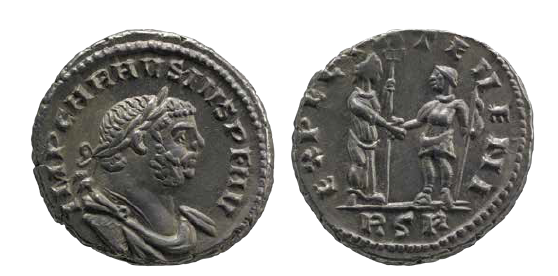
EXPECTATE VENI (RIC V.5 no. 68) © Trustees of the British Museum (Photo: Steven Dodd)
It seems a very long time ago, around Christmas 2009, when I was asked to write the new volume of Roman Imperial Coinage for Carausius (c. AD 286-93) and Allectus (c. AD 293-5/6). As with any major project, one is never aware of quite what is around the corner and, looking back, I realise that it was a much greater challenge than I could have imagined. My research was given a kick-start by the discovery of the Frome Hoard by metal-detectorist Dave Crisp in April 2010. 52,500 coins in one pot presents quite a prospect for conservation and cataloguing but the process was made a great deal more interesting by the presence of around 850 coins of Carausius, dating up to c. AD 291. Many of these coins feature in the new RIC volume, the find providing many new types and variants.
It was soon clear that with the demands of the ‘day job’, the work on RIC would be frustratingly slow, especially as I was asked to curate a Roman exhibition which was to tour four Continents of the World. This is where I am eternally grateful to Richard Beleson and Graham Barker who generously funded a ‘Deputy’ who could help with day-to-day work. Three people held this post successively: Philippa Walton, now a lecturer at Leicester University; Vincent Drost, now Curator of Roman Coins in the Bibliothèque nationale, Paris; and Andrew Brown, the new Curator of Roman Coins at the Ashmolean Museum, Oxford.
I have always been grateful to Roger Bland (one of the Editors of RIC) for advising me to ‘go back to the coins.’ This proved to be essential as I was to find numerous errors in previous catalogues. Percy Webb covered the coinages of Carausius and Allectus RIC V, Part 2 (1933), although most of this catalogue relied on corpora for the two emperors which he had published in the Numismatic Chronicle in 1906 and 1907. He was a lawyer, so working in his own time, and he lived in an era without word-processors, digital photography and email. Despite the problems inherent in his work, I have an enormous respect for what he achieved, providing a starting point for research with coins from most of the major museums and publications of the time. However, many of the his sources were unreliable and identifications were often incorrect. This comes as no surprise because for Carausius there are nigh on 200 obverse legend varieties, numerous mintmarks and a myriad of ways of depicting the same general reverse type. Furthermore, Webb conflated many varieties into one entry, further confusing the picture.
Webb did not have the benefit of much important scholarship from recent decades. For Carausius, there have been major publications by Norman Shiel, Brigitte Beaujard, Hélène Huvelin, John Casey, Roger Bland, Malcolm Lyne, Hugh Willams and Richard Bourne. For Allectus, Edward Besly and Andrew Burnett have made my life a lot easier with catalogues of his gold, radiates and Q-radiates. Alongside more recent research have been important discoveries, such as the Frome, Elveden and Rogiet hoards and single finds recorded on the Portable Antiquities Scheme database (finds.org.uk). In addition, I have visited or obtained images from almost 100 museums in Britain and around the world, have been generously given privileged access to important private collections and have had the benefit of online resources. It means that for Carausius, the number of types has increased from 1,260 in Webb’s RIC to 3,696 in the new volume, and from 250 to 569 for Allectus.
Creating a catalogue has not been easy. Given the enormous complexity of the coinage of Carausius, I finally organise the work by denomination, presenting the gold aurei, silver denarii, bronze ‘laureates’ and bronze radiates separately, even though this did cut across coins from the same mint or bearing similar mintmarks. This is because this will make the catalogue easier to use, a fundamental goal of any such work. In the Introduction, I attempt to present an overview of these pieces by mint and mintmark to present a narrative of the coinage. I also treat coins struck by Carausius for Diocletian and Maximian separately, again showing how they fit into the broader system in the Introduction. For Allectus, the gold all appears to emanate from London; it is followed by radiates and Q-radiates from London and then radiates and Q-radiates from the ‘C’ Mint. Within the Catalogue, the coins are categorised by mintmark; Webb tended to mix all the mintmarks for London and ‘C’ Mint amongst the entries.
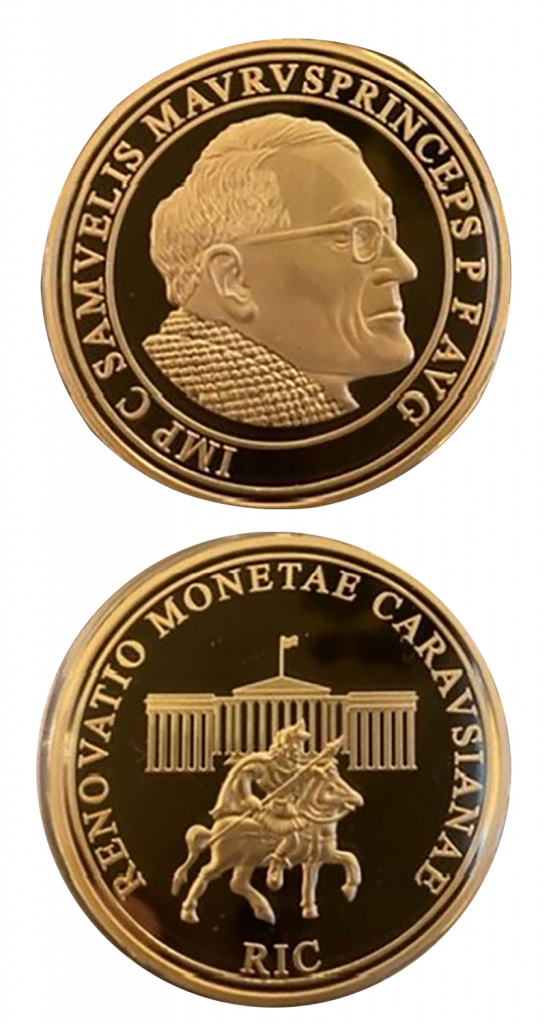
Now it is possible to see more clearly the structure of the coinage. However, the early years (c. AD 286-8) of Carausius’s reign is marked by a wide range of different mintmarks, including RSR, a plethora of miscellaneous marks (often numerals), unmarked coins and early London and ‘C’ Mint marks. The author has attempted to provide a narrative and tabulated outline of the nature and chronology of these different issues in the Introduction but there is still more work to be done. The unmarked coins provide a considerable challenge with over 1100 entries covering coins which show an enormous variety of style, apparently being struck from c. AD 287 to 290/1. I have attempted to attribute the coins to an early, intermediate and later style and, where possible, link to similar coins with London or ‘C’ Mint marks, but there is still much scope for further research.
In order to assist readers, I have made every effort, where possible, to provide images for each entry and for coins of different styles within an entry. The illustrations, ranging from old line drawings to pieces presented online, are included in 178 Plates. They will help scholars with future work, especially when considering die and style analyses. I need to acknowledge the enormous help of Robert Bracey in processing photographs of coins from numerous sources.
The nature of the ‘C’ Mint remains a mystery; it could even be a mint moving with the emperor (as the ‘Rouen’ Mint probably did when Carausius retreated to Britain). In the past, scholars have presented a neat order of ‘C’ mint marks; for the early years, I have shown this to be misconceived as the same marks, notably C and MC, appear to be used for different issues of coins struck over a period of several years. Across the early coinages of Carausius, up to around AD 291, only a detailed die and style study will present an even firmer understanding of the structure of the coinage. For the later issues, AD 291-3, the picture is much clearer, a phenomenon which continues into the coinage of Allectus.
However, for Allectus, building on Edward Besly’s publication of the Rogiet hoard, I am now convinced that the Q-radiates were not just struck at the end of the reign. Indeed, I can show that the QC coins were struck first at the ‘C’ Mint (with the Laetitia reverse) to be followed by QC and QL (London) coins with the Virtus reverse.
Before constructing the Catalogue, I recorded every coin for each type from every source in a corpus. This has enabled me to provide the number of specimens I have seen for each entry in the Catalogue. What is fascinating is that for Carausius well over 50% of the entries are only known from one specimen, rising to 80% for his silver issues. Surprisingly, given the better organisation of the coinage of Allectus, this figure does not drop significantly with figures from 37.5% to 55% for the common issues. This does show that die-engravers were given much leeway in the nature of types which they produced; in many cases, certain general reverse types in one issue could receive a wide variety of treatment with different spellings, for example TEMPORVM F, FE, FEL, FELI, FELIC, FELICI, FELICIT, FELICITA an FELICITAS! Unmarked coins of the Pax type are the most common pieces, but the single most common coin is the standard Pax type from the F O // ML issue. This is because the unmarked coins display an enormous variety of obverse legends.
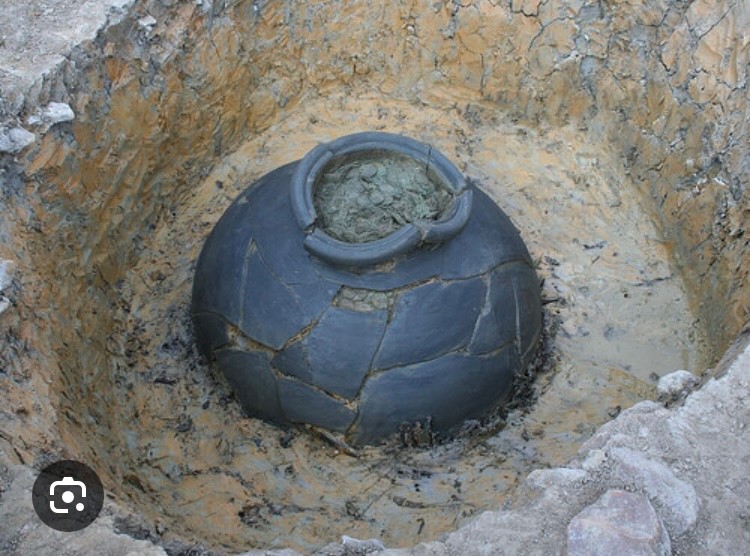
(Photo: Anna Booth)
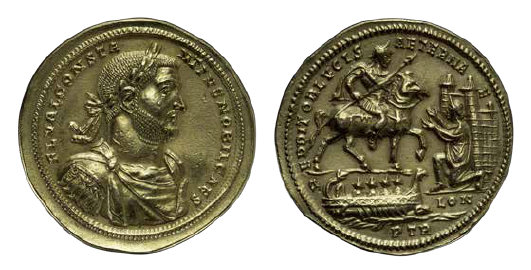
Because there are so many types recorded for Carausius, since the book entered into the final proof stages and has gone to press, a number of new types / varieties have emerged. There is no doubt that many more new coins will emerge in the coming decades as more hoards and are found and coins are recorded on the PAS Database. However, it will now be much easier to slot them into the Catalogue which will provide a simple structure for producing any Addenda. As new coins emerge and as scholars conduct new research and present new interpretations, our knowledge of the coinages of Carausius and Allectus will increase. When I started the work, Andrew Burnett told me that I should ‘leave things for other people to do’. Well, there is still an enormous amount of work to be done but I hope that this RIC will provide a solid foundation on which future scholars can build.
Fifteen years has been too long, but the project has been unavoidably extended by cancer and Covid. It is of great sadness to me that two people who provided so much help, David Miller and Malcolm Lyne, have not lived to see the final volume. I hope that, in the next world, they feel that they have received the credit which is undoubtedly due to them. I am also deeply indebted to Emma Howard, at Spink, for all her help and encouragement, and to Heather Dewhurst who was able to typeset such a leviathan (published in two volumes) with such patience and good humour.
Roman Imperial Coinage Volume V Part 5: Carausius and Allectus is available to order from Spink Books, www.spinkbooks.com
A tribute to Sam Moorhead by Richard Beleson:
I first met Sam Moorhead in 2011, when he was focusing his curatorial duties on the 900 coins of Carausius in the recently unearthed Frome Hoard. Roger Bland had approached me about providing funding for a junior finds curator position so that Sam could devote more of his time to the Frome Hoard coins, as well as beginning work on a revised edition of RIC V. As I was fascinated by both the coins of Carausius and Allectus, as well as coin hoards of Roman Britain, I was receptive to his proposal, and Philippa Walton was hired by the Department of Coins and Medals. When I actually met Sam, I am reminded of the scene at the end of the movie Casablanca, when the character played by Humphrey Bogart turns to the character played by Claude Reins, and says, “Louie, I think this is going to be the beginning of a beautiful friendship.” Little did Sam and I know that he was embarking upon a fifteen year project! Sam’s perseverance, persistence and enthusiasm never wavered, even in the face of Covid and other health challenges. I will never forget visiting the conservation lab at the British Museum with Sam and there was a pile of greenish coins from a fresh hoard laying on a table. There was a glint in his eye, and he somehow picked a coin out of the pile and said, “Oh, here’s a new Carausius type!” The most famous coin type of Carausius depicts Britannia greeting the new emperor with the inscription “EXPECTATI VENI,” which means, “Come, oh expected one!” It’s exactly how I feel about the publication of RIC V by Sam Moorhead.
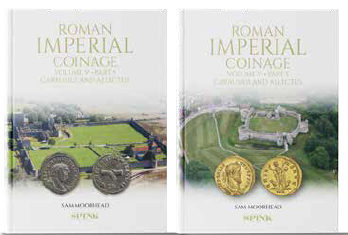
By Sam Moorhead
